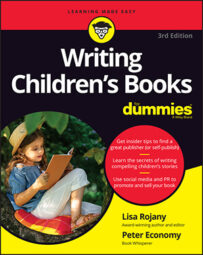The primary point of view (POV) decision you have to make before you can write even one sentence of your children's book is person. Third-person stories are told by a narrator who isn’t part of the story, whereas first- (and usually second-) person stories are told by a narrator who’s also a character.
First person: First person entails the author outright telling a story, perhaps his own, by being the main character of the story, narrating the book using the pronoun I. Your character (usually the protagonist) is telling the story through his own eyes.
First-person POV means the teller of the story cannot be omniscient (all-knowing), because regular people cannot be omniscient; as such, the teller of the story can report only what he or she can realistically know.
For example, she can’t know someone else’s private thoughts or what will happen in the future. Here’s an example:
I could not believe my eyes. There she was. Standing there in the outfit that we both admired yesterday at the mall. She hadn’t had the money to buy it then, so how had she come to be wearing it now? That was when I remembered the strange bulk in her shopping bag after we had left the department store. “My jacket,” she had said, noticing my look.
“Hi,” she now said, all cheerful and bright. “Like it?” She shimmied a little and laid a big smile on me, oblivious.
It was clear to me now. In this new school, I was clueless about the rules of right and wrong. I’d learn soon enough.
First-person POV is tough for a new writer to tackle because it requires truly establishing a unique voice and not getting caught up in your personal reality. Although it’s fun to experiment with various voices, most writers try to get plenty of experience writing in the third person before moving to first.
Second person: This perspective allows the writer to address the reader directly, using the pronoun you. Second-person POV is used when the writer wants to distance himself from his own involvement in the story and uses the word you in place of I.
Second-person POV is rare in published novels. Stories told in second person require an extremely skillful facility with voice and language; it’s a hard sell if it isn’t nearly perfect. You may feel your story warrants it, but wait until you’ve had a lot of practice writing before you tackle this particular beast.
Third person: Third-person POV is the author telling the story using the pronouns he, she, or they. Three types of third-person POV exist:
Third-person limited POV: In this type, the author gets to read the thoughts of only one main character.
Third-person multiple POV: Although this type allows you to tell the story through multiple characters’ viewpoints, most of the main action viewpoint is still reserved for the main character.
Third-person omniscient POV: This type is writing told from the viewpoint of a narrator who knows all and sees all — kind of like God. As a totally omniscient author, you are god. You can go into the mind of any character; report on anything that’s happening anywhere with anyone in the story at any time (even the future!); interpret any character’s actions or thoughts; reflect, judge, and reveal truths.
The main difference between the three types of third person is the amount of omniscience, or all-knowingness, the author chooses. For the record, most children’s books use the third-person limited POV; it’s also the easiest to master.

